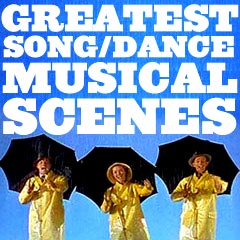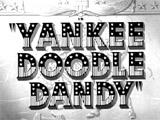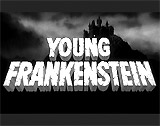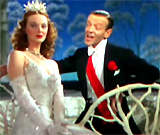
|
Musical Moments and Scenes X - Z |
| X - Z | ||
| Movie Title/Year and Scene Descriptions | ||

|
This well-known Warners' propagandistic, Best Picture-nominated musical biopic (mostly fictionalized and presented as a collection of musicals within a musical) by Hungarian-born director Michael Curtiz. It won three Oscars (from eight nominations): Best Actor (James Cagney), Best Sound Recording, and Best Musical Scoring of a Motion Picture. It starred James Cagney in his most famous role as bustling, jovial, and energetic song-and-dance man George M. Cohan. He appeared with iconic, flag-waving, rousing and patriotic performances. The many numbers included Cohan's:
There was also the scene of Cohan and his wife Mary (Joan Leslie) singing the duet Mary (pictured) at the piano together. One other memorable moment was his amazing, jaunty dance down the White House stairs (pictured) after visiting with President Roosevelt (Jack Young) - with a spontaneous, impromptu buck-wings tap dance midway. |
     
|

|
Yellow Submarine (1968, UK) Director George Dunning's landmark, trippy animated film featured many colorful, inventive animations. Its story was about the Beatles accompanying Captain Fred in his Yellow Submarine to venture to Pepperland to defeat the music-hating Blue Meanies. One special favorite was the psychedelic count of numbers to demonstrate the length of a 60-second minute in When I'm 64 (pictured). Another segment portrayed the ultimate end of the invasive Blue Meanies by the Sgt. Pepper's Band with the song All You Need Is Love (pictured), bringing the return of color to Pepperland. The live-action finale featured the actual Beatles singing the coda All Together Now (pictured twice). |
   
|

|
Yolanda and the Thief (1945) Director Vincente Minnelli disastrous box-office post-war fantasy musical (produced by Arthur Freed) was nonetheless a visionary and bold artistic experiment. The film was especially noted for juxtaposing colors and patterns within the dance sequences. Its original inspiration came from a magazine story by Ludwig Bemelmans. The plot was set in the fictional Latin American country of Patria. Its two main stars were ultimately involved in a romance:
The 15-minute surrealistic and colorful romantic duet Dream Ballet (pictured) combined components for its decor from both Salvador Dali and Jean Cocteau, and included Yolanda's song Will You Marry Me? During the jazzy, rhythmic dance number Coffee Time (pictured), the wavy and undulating B/W striped floor was contrasted with the brightly colored costumes. |
 
|
You Light Up My Life (1977)
Writer/director/producer/composer Joseph Brooks' low-budget romantic drama told about the aspirations and dreams of an obscure, mid-20s young singer of commercial jingles (and host of a kids show on public TV), who was looking to enter a career as a singer/songwriter. After initial disappointments and betrayal (regarding a promised acting role by a film director), her song (the title song) climbed the charts to become number one by the movie's conclusion. [Note: In an ironic twist, director Brooks took his own life in 2011 at the age of 73, while facing charges for alleged rapes and sexual assaults.] Its Oscar-winning title song You Light Up My Life (pictured often) (written by Brooks) was performed during an audition by struggling singer/songwriter Laurie Robinson (Didi Conn, dubbed by Kasey Cisyk) in an LA rehearsal room, surrounded by musicians:
Later in the film, there was a second version of the song, performed in a more subdued way on the piano (and sung to Laurie) by young film director, Chris Nolan (Michael Zaslow).
|
  
|
|

|
You Were Never Lovelier (1942) This Columbia Pictures film marked the second and last pairing of Astaire and Hayworth. It was their follow-up film to You'll Never Get Rich (1941):
There were three Oscar nominations (with no wins):
It featured an Oscar-nominated score, played by the Xavier Cugat's Latin band, including such standards-to-be as:
The musical-dance film also included:
|
    |

|
You'll Never Get Rich (1941) This Columbia Pictures film by director Sidney Lanfield, an entertaining war-time 'military' musical with a Cole Porter score, was the first pairing of Astaire and Hayworth:
There were two Oscar nominations (with no wins):
The songs included:
Another dance number was the tap-dancing Boogie Barcarolle (pictured) led by Astaire as choreographer/teacher of Hayworth and a group of chorines during a rehearsal. And in the finale The Wedding Cake Walk (pictured) (sung by Martha Tilton), the two danced in their formal wedding clothes atop a white tank that was positioned above a giant wedding cake. |
    
|

|
In this Mel Brooks' homage to the classic Universal horror film and the singing/dancing of Fred Astaire, Dr. Frederick Frankenstein (Gene Wilder) introduced the Monster (Peter Boyle) to a Bucharest Academy audience as a "man about town." Then, they performed a classic top-hat and cane, tap-dancing duet of Irving Berlin's Puttin' on the Ritz (pictured) in a theatre in front of an audience - with the Monster's slurred, squeaky, and high-pitched singing of the mis-pronounced: "Punnondariiiiiiiizz!" However, the Monster went mad and attacked the audience.
Afterwards, Frankenstein's fiancee Elizabeth (Madeline Kahn) was kidnapped from her Transylvanian castle bedroom by the escaped Monster. When she awoke from unconsciousness in the forest (with white hair streaks), she realized she was about to be raped, but then looked down - and was pleasingly shocked during her sexual encounter with the Monster when she sighted his enormous penis (Schwanstucker). She reacted with: "WOOF!" In the musically-enhanced sex scene, she also warbled one line of the tune: O, Sweet Mystery of Life (pictured) - (Victor Herbert's composition from 1910). Afterwards, they shared a post-coitus cigarette (in the manner of Now, Voyager (1942)) (pictured) and she complimented him on his stamina: "Penny for your thoughts. You're incorrigible, aren't you? You little zipper-neck." Also in the ending after a transference operation with the creature, Dr. Frankenstein was now endowed with the Monster's enormous Schwanstucker - about to please his new bride Inga (Teri Garr), his ex-lab assistant. She asked: "The monster got part of your wonderful brain. But what did you ever get from him?" There was a zoom-in closeup of Frankenstein's expectant face and the fireplace as Inga screamed out ecstatically off-screen: "Oh, I don't believe, oh, oh, O, Sweet Mystery of Life." In the meantime, Elizabeth - sporting a beehive hairdo - was now married to the more intellectual Monster (reading The Wall Street Journal in bed) and was bedding down with him in her New York apartment. |
     
|

|
Ziegfeld Follies (1945) This all-star MGM extravaganza revue and musical comedy by director Vincente Minnelli (and others) brought together many stars and memorable songs by George and Ira Gershwin in the Ziegfeld style. It starred singer-dancer Fred Astaire in his first color film and many other performers, including Lucille Ball, Lucille Bremer, Fanny Brice, Judy Garland, Esther Williams, Gene Kelly, Kathryn Grayson, Lena Horne and Red Skelton. Remarkably, it had no Academy Award nominations. It was intended as a follow-up film to the Best Picture-winning The Great Ziegfeld (1937) and Ziegfeld Girl (1941). The musical numbers included:
Astaire also performed two exquisite numbers with Lucille Bremer:
In their only screen duet pairing, Gene Kelly and Fred Astaire (dressed alike as white-suited gentlemen) performed The Babbitt and the Bromide (pictured) (a George and Ira Gershwin tune) - a challenge dance matching each other step for step. Also notable was Lena Horne's performance of the sexy number Love (pictured) against a Virgin Islands Caribbean backdrop. |
       
|

|
Ziegfeld Girl (1941) This was a lavish musical attempt by MGM to again use the Ziegfeld legend from the Best Picture-winning The Great Ziegfeld (1937) in a film - although this one was filmed in dull black and white. Its soap-opera plot about a backstage musical told of three showgirls as they attempted to make the Ziegfeld chorus line:
One of the two splashy musical numbers featured Judy Garland who sang and danced to a calypso beat in a Caribbean tropical setting to Minnie From Trinidad (pictured). Another major number was the extravagant finale You Stepped Out of a Dream (pictured twice), co-directed by choreographer Busby Berkeley, in which Ziegfeld Follies chorus girls elegantly paraded down staircases in costumes (designed by Adrian) as Tony Martin (as Frank Merton, the male singing star of the show) sang. |
  
|
(alphabetical by film title) Introduction | A-1 | A-2 | B-1 | B-2 | B-3 | C-1 | C-2 | D-1 | D-2 | E | F-1 | F-2 | G-1 | G-2 H-1 | H-2 | I-J | K | L-1 | L-2 | M-1 | M-2 | N-O | P-1 | P-2 | R-1 | R-2 | S-1 | S-2 | S-3 | T | U-V | W | X-Z |